| Author |
Message |
Rodolfo Martínez

|
 Posted: Sat 17 May, 2008 8:17 pm Post subject: XiIi Century warfare Posted: Sat 17 May, 2008 8:17 pm Post subject: XiIi Century warfare |
 |
|
Hello people.
I was reading the fantastic article about great helmets, and it came to my mind XIII century...
Wich weapons and armours were used by men-at-arms during that century?
Maces?
Warhammers?
Where bastard-swords used single handed with heather shields?
What about horses?
In art they are shown with a coloured padded garment, Do you know if the mail armour of the horse, was used under such garment?
Thanks
http://www.heraldry-scotland.co.uk/images/melee.jpg
P.D.
Why there is almost none contemporary picturo showing horses with mail-bard?
 Attachment: 15.82 KB Attachment: 15.82 KB
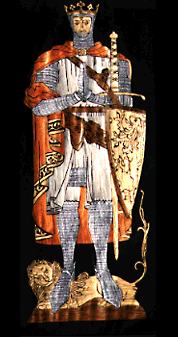
See this effigy, Do you think that they used such swords?
¨Sólo me desenvainarás por honor y nunca me envainarás sin gloria¨
|
|
  |
 |
Chad Arnow
myArmoury Team


|
 Posted: Sat 17 May, 2008 8:21 pm Post subject: Posted: Sat 17 May, 2008 8:21 pm Post subject: |
 |
|
Roldolfo,
The image you showed is a brass, not an effigy (there is a difference  ). It's that of Robert the Bruce and was laid centuries after his death. I wouldn't rely on it. ). It's that of Robert the Bruce and was laid centuries after his death. I wouldn't rely on it.
Maces were known, like A&A's Iberian Mace and others with heads of materials like bronze.

ChadA
http://chadarnow.com/
|
|
    |
 |
Elling Polden

|
 Posted: Sun 18 May, 2008 5:10 am Post subject: Posted: Sun 18 May, 2008 5:10 am Post subject: |
 |
|
The main wepons of the 13th century where spear, often one handed, shield and one handed sword.
Bastard/great swords where starting to appear, but whene not yet common by the end of the century.
Maces where also around, but where not all that common either; the mace as a specialized anti armour weapn appeared later. Warhammers where not yet around.
By the end of the century, one was gravitating from the traditional spear and shield towards twohanded spears and heavy armour.
In short, the specialized anti-armour weapons where not yet introduced; they where a product of later plate armours. Presumably the weapons in use where sufficient to deal with the armour of the day, with a bit of effort.
"this [fight] looks curious, almost like a game. See, they are looking around them before they fall, to find a dry spot to fall on, or they are falling on their shields. Can you see blood on their cloths and weapons? No. This must be trickery."
-Reidar Sendeman, from King Sverre's Saga, 1201
|
|
    |
 |
Rodolfo Martínez

|
 Posted: Sun 18 May, 2008 9:26 am Post subject: Posted: Sun 18 May, 2008 9:26 am Post subject: |
 |
|
Thanks for the answers guys.
Elling:
You talked about spears, Where this spears used for cavalry charges, or are the ones used on foot too?
About horses.
Normand knights had horses with some kind of mail, if i´m not wrong, Why then, the representations of horses wearing mail armour of this century aren´t as common as the ones showing the wearing the cloth tunic or the padded garment?
Axes are pretty brutal with mail, Where axes used by knights during XIII century too?
And what about shields?
Were Kite shields still used, or they were replaced by heather shields?
¨Sólo me desenvainarás por honor y nunca me envainarás sin gloria¨
|
|
  |
 |
Elling Polden

|
 Posted: Sun 18 May, 2008 10:26 am Post subject: Posted: Sun 18 May, 2008 10:26 am Post subject: |
 |
|
Spears where used both on horseback and on foot, and for throwing.
A spear is a very efficient anti-armour weapon; It focuses huge amounts of energy on a single point.
Axes where in use, but swords still seem to have been a more common choice. these are either two handed or long handled one handed versions, and not the short hafted horsemans axes used in later centuries.
As for their effectiveness against mail, they deliver a punch, but in any case killing someone in mail with any weapon (save maybe two handed spear) will require several blows, and most likely close action; My guess is that the long hafted axe was used for hard initial blows, after which it was dropped in favour of a dagger to finish a stunned foe.
Against unarmoured men, of course, it will be devastating.
There is a picture of a barded horse in Edward the confessor;
http://www.lib.cam.ac.uk/cgi-bin/Ee.3.59/imag...&t=png
"this [fight] looks curious, almost like a game. See, they are looking around them before they fall, to find a dry spot to fall on, or they are falling on their shields. Can you see blood on their cloths and weapons? No. This must be trickery."
-Reidar Sendeman, from King Sverre's Saga, 1201
|
|
    |
 |
|
Scott Kowalski
Location: Oak Lawn, IL USA Joined: 24 Nov 2006
Posts: 818
|
 Posted: Sun 18 May, 2008 11:05 am Post subject: Posted: Sun 18 May, 2008 11:05 am Post subject: |
 |
|
| Elling Polden wrote: |
Axes where in use, but swords still seem to have been a more common choice. these are either two handed or long handled one handed versions, and not the short hafted horsemans axes used in later centuries.
http://www.lib.cam.ac.uk/cgi-bin/Ee.3.59/imag...&t=png |
Elling, when you say long handled one hand versions just how long? in the 60 to 62 centimeter range? Or even longer? At which point what would the weight be? I am interested because I am looking at picking up an axe for right around 1300.
Scott
|
|
  |
 |
|
Doug Lester
Location: Decatur, IL Joined: 12 Dec 2007
Posts: 167
|
 Posted: Sun 18 May, 2008 11:28 am Post subject: Posted: Sun 18 May, 2008 11:28 am Post subject: |
 |
|
|
First of all, don't confuse a picture of a tournament with what happens on the battlefield. I'm hardly an expert, but I don't remember any references to armouring horses during this period. If what you mean by men-at-arms are mounted and armoured fighters made up of knights, squires, and seargents, then their primary weapon would be a lance with a sword as a secondary weapon. The sword would probably have a rather long blade, somewhere around 34-36 inches for additional reach, though shorter double edged swords and falchions were carried. I have seen some references that stated that a long sword was carried on the saddle for fighting from horse back and a shorter sword, or the falchion, was carried as a backup or if the man-at-arms had to dismount and fight on foot. It's not clear from the reading that I have done, but I am wondering how common it was to carry two swords. It's sort of like daggers/knives. There are few pictures of or references to men-at-arms carrying such weapons during the XIII century or earlier but it is pretty reasonable to assume that they were carried. It would seem to me that if a fighter did posess two swords he might want to carry one as a backup weapon.
|
|
  |
 |
Rodolfo Martínez

|
 Posted: Sun 18 May, 2008 1:14 pm Post subject: Posted: Sun 18 May, 2008 1:14 pm Post subject: |
 |
|
| Doug Lester wrote: | | First of all, don't confuse a picture of a tournament with what happens on the battlefield. I'm hardly an expert, but I don't remember any references to armouring horses during this period. If what you mean by men-at-arms are mounted and armoured fighters made up of knights, squires, and seargents, then their primary weapon would be a lance with a sword as a secondary weapon. The sword would probably have a rather long blade, somewhere around 34-36 inches for additional reach, though shorter double edged swords and falchions were carried. I have seen some references that stated that a long sword was carried on the saddle for fighting from horse back and a shorter sword, or the falchion, was carried as a backup or if the man-at-arms had to dismount and fight on foot. It's not clear from the reading that I have done, but I am wondering how common it was to carry two swords. It's sort of like daggers/knives. There are few pictures of or references to men-at-arms carrying such weapons during the XIII century or earlier but it is pretty reasonable to assume that they were carried. It would seem to me that if a fighter did posess two swords he might want to carry one as a backup weapon. |
There were longswords in that time, they were the Type XIIa if i´m not wrong, but i don´t know if they were used by knights.
About horse barding.... i´m pretty sure that in History Channel, in ¨Conquest¨ Peter Woodward said that horses were armored with mail (If having enough $$$)
In Maciejlowski bible, there is a plate showing a knight fighting with a two handed sword from horseback, i´ll try to fing it.
Elling:
When you talk about long handled versions of axes, Are you refering to axes used with shields too?
How long are this axes? Do they have the pick in the other side of the edge?
¨Sólo me desenvainarás por honor y nunca me envainarás sin gloria¨
|
|
  |
 |
Elling Polden

|
 Posted: Sun 18 May, 2008 1:29 pm Post subject: Posted: Sun 18 May, 2008 1:29 pm Post subject: |
 |
|
There are not all that many sources for one handed axes, as far as I know. Here in Norway, there is one preserved axe fram the middle ages (a river find) that has a 110cm shaft.
Since a sword will make short work of an axe at close range, having a long handle makes sense. Techniques would probably be along the lines of the longsword Zornhau; Hit him in the side of the head as hard as you can, and hope he fails his block.
An axe this length can also be used in two hands, longsword style, if no sword is available.
Norwegian farmer would carry axes for self defense and as a status symbol all the way up to the 18th century. These axes where also in the 1m range, which let them be comfortably used as walking staffs; presumably at least some axes in the middle ages where carried in a similar fashion.
 Attachment: 42.51 KB Attachment: 42.51 KB
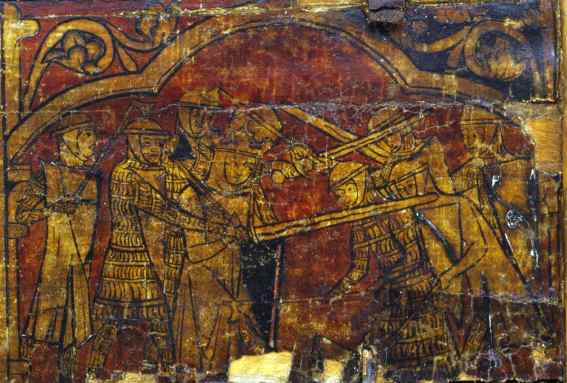
The death of St. Olav, norwegian church frontal, mid 13th century
"this [fight] looks curious, almost like a game. See, they are looking around them before they fall, to find a dry spot to fall on, or they are falling on their shields. Can you see blood on their cloths and weapons? No. This must be trickery."
-Reidar Sendeman, from King Sverre's Saga, 1201
|
|
    |
 |
|
Scott Kowalski
Location: Oak Lawn, IL USA Joined: 24 Nov 2006
Posts: 818
|
 Posted: Sun 18 May, 2008 2:21 pm Post subject: Posted: Sun 18 May, 2008 2:21 pm Post subject: |
 |
|
Do not forget about the XIIIa typology when speaking of great swords in the latter half of the century as well. Not good for the thrust but a heavy duty cutter.
As to the disadvantages of using an axe I totally ignored that. Though with the balance of an axe being focused on the head I wonder how long of an axe could be wielded one handed and still be able to easily control it. At a certain length I would imagine that it would become an all another weapon owing to the fact that a quick recovery would become almost impossible.
Scott
|
|
  |
 |
Rodolfo Martínez

|
 Posted: Sun 18 May, 2008 3:18 pm Post subject: Posted: Sun 18 May, 2008 3:18 pm Post subject: |
 |
|
| Scott Kowalski wrote: | Do not forget about the XIIIa typology when speaking of great swords in the latter half of the century as well. Not good for the thrust but a heavy duty cutter.
As to the disadvantages of using an axe I totally ignored that. Though with the balance of an axe being focused on the head I wonder how long of an axe could be wielded one handed and still be able to easily control it. At a certain length I would imagine that it would become an all another weapon owing to the fact that a quick recovery would become almost impossible.
Scott |
So then, Anybody has a clue about XIIa swords being used by knights?
¨Sólo me desenvainarás por honor y nunca me envainarás sin gloria¨
|
|
  |
 |
Chad Arnow
myArmoury Team


|
 Posted: Sun 18 May, 2008 4:22 pm Post subject: Posted: Sun 18 May, 2008 4:22 pm Post subject: |
 |
|
| Rodolfo Martínez wrote: | | So then, Anybody has a clue about XIIa swords being used by knights? |
I don't know why knights wouldn't use them.  There are surviving Type XIIa swords that have decoration and styles well-suited to the knightly class. There are surviving Type XIIa swords that have decoration and styles well-suited to the knightly class.
I think it's fairly safe to assume knights would have used every Oakeshott Type of blade. Most of the Types represented an innovation in shape. As the needs of the wealthy warrior (knights and nobility) were big drivers in weapons innovation, I think cutting-edge knights (no pun intended) would want the "latest and greatest" and would be buyers of any design that offered an advantage over an older design.
The Type XIIa was basically an improvement over less pointed swords and/or smaller swords, so I would be surprised if knights didn't use it.

ChadA
http://chadarnow.com/
|
|
    |
 |
Rodolfo Martínez

|
 Posted: Sun 18 May, 2008 7:20 pm Post subject: Posted: Sun 18 May, 2008 7:20 pm Post subject: |
 |
|
| Chad Arnow wrote: | | Rodolfo Martínez wrote: | | So then, Anybody has a clue about XIIa swords being used by knights? |
I don't know why knights wouldn't use them.  There are surviving Type XIIa swords that have decoration and styles well-suited to the knightly class. There are surviving Type XIIa swords that have decoration and styles well-suited to the knightly class.
I think it's fairly safe to assume knights would have used every Oakeshott Type of blade. Most of the Types represented an innovation in shape. As the needs of the wealthy warrior (knights and nobility) were big drivers in weapons innovation, I think cutting-edge knights (no pun intended) would want the "latest and greatest" and would be buyers of any design that offered an advantage over an older design.
The Type XIIa was basically an improvement over less pointed swords and/or smaller swords, so I would be surprised if knights didn't use it. |
Great!
Do you think that they could use them with shield too?
About techniques, Do you know if Fiore or Goliath for example, could be talking about techniques used in warfare, and teached orally during middle ages?
I can´t imagine a knight using this sword, fighting like Monty Python´s black knight.
P.D.
I have woodcuts of XVI century knights using ¨Durer¨swords, some of them are from the triumphs of Maximilian, maybe such kind of sword wasn´t as primitive for that era as it appears. And, if such sword can be used from horseback, i can´t see why a shield can´t be used with a longsword (I don´t know if history backs me). Bastard/ Longswords are excellent designs.
Can i upload some of them?
Do you know wich type of bastard sword replaced it for mounted combat?
¨Sólo me desenvainarás por honor y nunca me envainarás sin gloria¨
|
|
  |
 |
Chad Arnow
myArmoury Team


|
 Posted: Sun 18 May, 2008 8:17 pm Post subject: Posted: Sun 18 May, 2008 8:17 pm Post subject: |
 |
|
| Rodolfo Martínez wrote: | Great!
Do you think that they could use them with shield too? |
Some could probably be used with a shield, some definitely not. If it's a true great sword, you'll probably need two hands on the grip, leaving nothing free for a shield.
| Rodolfo Martínez wrote: | P.D.
I have woodcuts of XVI century knights using ¨Durer¨swords, some of them are from the triumphs of Maximilian, maybe such kind of sword wasn´t as primitive for that era as it appears. And, if such sword can be used from horseback, i can´t see why a shield can´t be used with a longsword (I don´t know if history backs me). Bastard/ Longswords are excellent designs.
Can i upload some of them? |
You can upload pics if they pertain to this thread (or you start a new one) until your upload limit expires. Please don't upload anything whose copyright will get us in trouble, though.
A longer sword (longsword and some great swords) can be used from horseback, but I've always heard the techniques differ from how they'd be used on foot. On horseback, you'd probably most often be making large sweeping cuts in a downward motion. On foot, you have more options (as you don't have to avoid cutting off your horse's head) and would need to be more agile with the sword.
| Rodolfo Martínez wrote: | | Do you know wich type of bastard sword replaced it for mounted combat? |
I'm afraid I don't understand the question. Are you talking Oakeshott types or some other category? Either way it's going to be tough to answer. Some people continued using Type XIIa and XIIIa blades right up into the Renaissance. Some people replaced them with smaller bastard swords. Or arming swords. Or staff weapons.
There was no universal rule. It would be rare if something new led to the complete abandonment of older designs.
Of course, some knights supposedly strapped one sword to their belt and a longer one to their saddle.

ChadA
http://chadarnow.com/
|
|
    |
 |
Craig Peters

|
 Posted: Sun 18 May, 2008 9:58 pm Post subject: Posted: Sun 18 May, 2008 9:58 pm Post subject: |
 |
|
| Rodolfo Martínez wrote: |
About techniques, Do you know if Fiore or Goliath for example, could be talking about techniques used in warfare, and teached orally during middle ages?
|
Insofar that there will be inevitable cross-over in the methods of fighting with long swords and single handed swords, yes. That's why the long sword is so often taught as a foundational weapon in historic European martial arts these days, aside from the fact that it seems to appear most frequently in period manuscripts. Once you've got a good, solid foundation in long sword, you know a lot of the principles and applications of fighting which allow you to more easily pick-up other weapons.
I suspect, however, that fighting in the High Middle Ages was more consistent with what we see in MS I.33. Simply put, a fighting method that involves a single handed sword and buckler is going to be far closer to medieval sword and shield fighting by nature. I've done some research into iconographical evidence for fighting techniques and methods prior to MS I.33, and while the evidence is scanty, there does seem to be some indication of similarities between I.33 and earlier illustrations (especially in regards to guards) which should hardly be surprising.
The more tricky thing is determining whether a specific action for the long sword would have been used for the single handed sword. Was, for instance, the Zwerchhaw used with a single handed sword? It's hard to say. Certainly, it is far easier to deliver a Zwerch with a two handed sword. And I don't think its application as one of the Funff Hawe/Meisterhawen can be properly exploited with one hand, since you'd almost certainly be unable to resist the force of an incoming strike. More to the point, it's necessity as a master cut would diminish, because you've already got a buckler or shield.
But does that mean to say that a one handed Zwerch was unknown or unused? Well, we don't really know. All we can do is speculate.
|
|
  |
 |
Elling Polden

|
 Posted: Mon 19 May, 2008 6:03 am Post subject: Posted: Mon 19 May, 2008 6:03 am Post subject: |
 |
|
Most likely the early greatswords where threated like single handers on horseback. As for their use on foot at this time I can't come up with any examples.
While grabbing the sword with both hands is a well known way to fight, (often used in literature to describe someone who goes berserk and abandons caution) long handles swords are not shown in high medevial imagery. Even though they appear in the archeolgical material.
This would indicate that they where not seen as a distinct class of weapon; A sword was a a sword. Later, when shields become less common, the consept of using long handled swords in two hands gain hold, and artists start to depict them.
In this respect one should keep in mind that there are plenty of XI's and XII that have as long blades as the XIIa. (90cm+ isn't unheard of). In it's saddle sword function, the longer handle is a minor feature.
One should also keep in mind that knigths DO have their left hands free even when equiped with shields. Most of them utilize a guige strap and som variant of strap arrangement that lets the have the left hand free to hold the reins.
This also allows you to use a two handed weapon with the shield in place.
If you take a look at the shield on the ground in the mounted fight scene from Eddy C, you will see that that the shield has a small vertical grip in the center, a horisontal arm strap, a long handstrap along the edge and a guige.

In use, the arm is passed DOWN throuh the horisontal arm strap, and the guige put over the head. The hand is then slipped under the handstrap, so that the strap rests at the wrist/under arm, whith the hand free.
This firmly attacthes the shield to the upper arm, while allowing you to move you hand up and down, hold the reins, or use a two handed weapon. You can even block blows to the head by lifting the arm.
Most likely knights would reatain these shields when fighting on the ground, with their lances as spears. While great helms priovide good protection, even a blunt two handed spear can deliver thrusts to the head that can tip you over.
"this [fight] looks curious, almost like a game. See, they are looking around them before they fall, to find a dry spot to fall on, or they are falling on their shields. Can you see blood on their cloths and weapons? No. This must be trickery."
-Reidar Sendeman, from King Sverre's Saga, 1201
|
|
    |
 |
Rodolfo Martínez

|
 Posted: Mon 19 May, 2008 7:31 am Post subject: Posted: Mon 19 May, 2008 7:31 am Post subject: |
 |
|
I´ll upload the later, because the uploader uploads several times the same image.
About hoses.... again.
I´m really curious about how horses were protected then, if mail was used for the tournament?
 Attachment: 38.38 KB Attachment: 38.38 KB
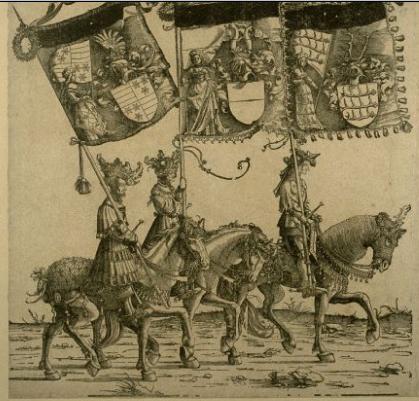
 Attachment: 38.38 KB Attachment: 38.38 KB

 Attachment: 38.38 KB Attachment: 38.38 KB
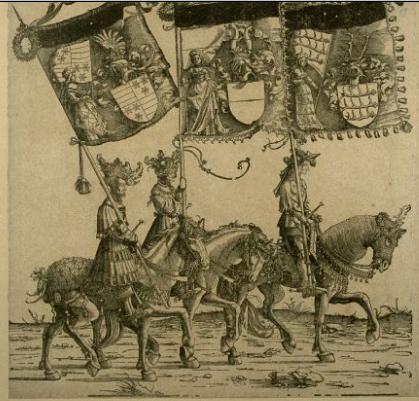
¨Sólo me desenvainarás por honor y nunca me envainarás sin gloria¨
|
|
  |
 |
Rodolfo Martínez

|
 Posted: Mon 19 May, 2008 3:24 pm Post subject: Posted: Mon 19 May, 2008 3:24 pm Post subject: |
 |
|
| Chad Arnow wrote: | | Rodolfo Martínez wrote: | Great!
Do you think that they could use them with shield too? |
Some could probably be used with a shield, some definitely not. If it's a true great sword, you'll probably need two hands on the grip, leaving nothing free for a shield.
| Rodolfo Martínez wrote: | P.D.
I have woodcuts of XVI century knights using ¨Durer¨swords, some of them are from the triumphs of Maximilian, maybe such kind of sword wasn´t as primitive for that era as it appears. And, if such sword can be used from horseback, i can´t see why a shield can´t be used with a longsword (I don´t know if history backs me). Bastard/ Longswords are excellent designs.
Can i upload some of them? |
You can upload pics if they pertain to this thread (or you start a new one) until your upload limit expires. Please don't upload anything whose copyright will get us in trouble, though.
A longer sword (longsword and some great swords) can be used from horseback, but I've always heard the techniques differ from how they'd be used on foot. On horseback, you'd probably most often be making large sweeping cuts in a downward motion. On foot, you have more options (as you don't have to avoid cutting off your horse's head) and would need to be more agile with the sword.
| Rodolfo Martínez wrote: | | Do you know wich type of bastard sword replaced it for mounted combat? |
I'm afraid I don't understand the question. Are you talking Oakeshott types or some other category? Either way it's going to be tough to answer. Some people continued using Type XIIa and XIIIa blades right up into the Renaissance. Some people replaced them with smaller bastard swords. Or arming swords. Or staff weapons.
There was no universal rule. It would be rare if something new led to the complete abandonment of older designs.
Of course, some knights supposedly strapped one sword to their belt and a longer one to their saddle. |
I was talking about if new sword types emerged to replace older medieval ones, but the las sword in this article answers me.
http://www.myArmoury.com/feature_spotxiii.html
Scott:
Do not forget about the XIIIa typology when speaking of great swords in the latter half of the century as well. Not good for the thrust but a heavy duty cutter. | Quote: |
Sorry man, i forgot those wonderful blades.
Elling:
About Flemish spears, Goedendags, Do you know How knights protected their horses against it?
If horses only used mail in tournaments then, in battle, What did they use to protect against spears or such staff weapons?
Do you know if such horses were Stallions too? (Those who bite and kick, like Renaissance ones)
|
¨Sólo me desenvainarás por honor y nunca me envainarás sin gloria¨
|
|
  |
 |
Elling Polden

|
 Posted: Mon 19 May, 2008 3:44 pm Post subject: Posted: Mon 19 May, 2008 3:44 pm Post subject: |
 |
|
Bardings are quite definitely around; they are called for in the english arms requirement for knights, for instance.
They are not depicted all that often, though.
As for the godendag, it is only efficient against knights if these are stupid enough to charge a prepared defensive position head on and fall in a ditch...
In most cases, a knight would make short work of a man armed such.
A regular spear, being longer, would probably be more bothersome.
http://medievalhistory.mysite.wanadoo-members.co.uk/
includes a thesis which contains the english arms requirements from 1200 onwards.
"this [fight] looks curious, almost like a game. See, they are looking around them before they fall, to find a dry spot to fall on, or they are falling on their shields. Can you see blood on their cloths and weapons? No. This must be trickery."
-Reidar Sendeman, from King Sverre's Saga, 1201
|
|
    |
 |
|
Nicholas A. Gaese
Location: Montreal, Quebec, Canada Joined: 06 Aug 2007
Posts: 100
|
 Posted: Mon 19 May, 2008 5:37 pm Post subject: Posted: Mon 19 May, 2008 5:37 pm Post subject: |
 |
|
Hello all!
Rudolfo, earlier you were looking for a picture of knight and an early use of a two-handed sword. I have a picture of a knight cleaving a man with one of the interesting Maciowski Bible choppers. Is this the photo you were looking for?
 Attachment: 39.2 KB Attachment: 39.2 KB
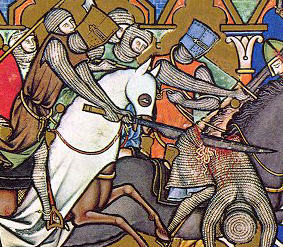
|
|
  |
 |
|
|
You cannot post new topics in this forum
You cannot reply to topics in this forum
You cannot edit your posts in this forum
You cannot delete your posts in this forum
You cannot vote in polls in this forum
You cannot attach files in this forum
You can download files in this forum
|
All contents © Copyright 2003-2025 myArmoury.com — All rights reserved
Discussion forums powered by phpBB © The phpBB Group
Switch to the Basic Low-bandwidth Version of the forum
|

